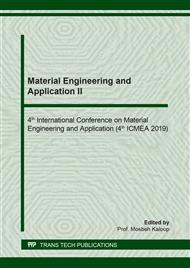[1]
A. Zeren, Embeddability behaviour of tin-based bearing material in dry sliding, Mater. Design, 28 (2007) 2344-2350.
DOI: 10.1016/j.matdes.2006.06.020
Google Scholar
[2]
A. Zeren, E. Feyzullahoglu, M. Zeren, A study on tribological behaviour of tin-based bearing material in dry sliding, Mater. Design, 28 (2007) 318-323.
DOI: 10.1016/j.matdes.2005.05.016
Google Scholar
[3]
M. M. Goudarzi, S. A. J. Jahromi, A. Nazarboland, Investigation of characteristics of tin-based white metals as a bearing material, Mater. Design, 30 (2009) 2283-2288.
DOI: 10.1016/j.matdes.2008.07.056
Google Scholar
[4]
P. Diouf, A. Jones, Investigation of Bond Strength in Centrifugal Lining of Babbitt on Cast Iron, Metallurgical Mater. Transact. a-Physical Metallurgy Mater. Sci. 41A (2010) 603-609.
DOI: 10.1007/s11661-009-0112-y
Google Scholar
[5]
Y. S. Korobov, S. V. Nevezhin, M. A. Filippov, V. V. Ilyushin, B. A. Potekhin, L. V. Gogolev, Effect of production methods on tribological characteristics of babbitt coatings, J. Friction Wear, 33 (2012) 190-194.
DOI: 10.3103/s1068366612030063
Google Scholar
[6]
M. Z. Wei, K. Sun, X. L. Zhang, C. Zhang, Z. H. Chen, J. Zhou, F. Xue, Microstructure and bonding strength of tin-based Babbitt alloy on ASTM 1045 steel by MIG arc brazing, J. Adhesion Sci. Technol. 32 (2018) 2150-2161.
DOI: 10.1080/01694243.2018.1464239
Google Scholar
[7]
X. M. Song, F. L. Meng, M. G. Kong, Y. Z. Wang, L. P. Huang, X. B. Zheng, Y. Zeng, Thickness and microstructure characterization of TGO in thermal barrier coatings by 3D reconstruction, Mater. Characterization, 120 (2016) 244-248.
DOI: 10.1016/j.matchar.2016.09.006
Google Scholar
[8]
S. S. Singh, C. Schwartzstein, J. J. Williams, X. H. Xiao, F. De Carlo, N. Chawla, 3D microstructural characterization and mechanical properties of constituent particles in Al 7075 alloys using X-ray synchrotron tomography and nanoindentation, J. Alloys Compounds, 602 (2014) 163-174.
DOI: 10.1016/j.jallcom.2014.03.010
Google Scholar
[9]
M. A. Dudek, L. Hunter, S. Kranz, J. J. Williams, S. H. Lau, N. Chawla, Three-dimensional (3D) visualization of reflow porosity and modeling of deformation in Pb-free solder joints, Mater. Characterization, 61 (2010) 433-439.
DOI: 10.1016/j.matchar.2010.01.011
Google Scholar
[10]
X. He, Ieee, Reconstruction of 3D microstructure of the rock sample basing on the CT images, in: 7th Int. Conf. Wavelet Analysis and Pattern Recognition, Baoding, PEOPLES R CHINA, (2009) 74-78.
DOI: 10.1109/icwapr.2009.5207428
Google Scholar


